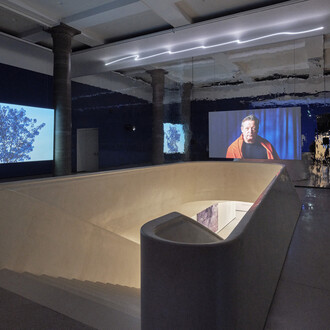The Frankfurter Kunstverein has invited Yves Netzhammer, Theo Jansen, and Takayuki Todo to present a selection of their works in solo shows, under the shared thematic title “Empathic Systems.”
“SEER” is a humanoid robotic head developed as an artistic work by Takayuki Todo. It explores the significance of gaze and facial expression in the sphere of human-machine research.
The art of hyperrealistic sculpture has existed for over 4000 years. Sculptors from different stylistic eras consistently aimed to reproduce reality as vividly as possible. Classical art sought to breathe life into a figure, whether as an archetypal symbol or the portrait of an individual. To this end, artists developed methods and used stylistic devices to capture what renders a being alive in an image: the gaze. The gaze is a central feature of the individual expression of mental states. Eye contact is one of the strongest forms of communication between two beings, one of the most elemental forms of (visual) connection. It takes place beyond language and creates a direct exchange between two individuals – who do not necessarily have to be human. Eye contact represents a mutual perception by the living, who recognize each other in their aliveness. Through their subjects’ gaze, sculpture, painting, photography, and cinematography try for a moment to override the separation between the here of the viewer and the there of the fictional figure.
Takayuki Todo is interested in how people establish an emotional relationship with humanoid robots. As the discipline of robotics has shown for years, a realistic similarity to the human form alone is not able to break down the distance between a human and a machine. The term “uncanny valley” refers to this very narrow but significant gap between what a person perceives as real and credible, and what they perceive as artificial and uncanny.
For Todo, the central element that offers a way out of the “uncanny valley” is the gaze. For years he has been working on anthropomorphic figures that are made of entirely synthetic materials yet acquire a liveliness through their gaze. Created in 2018, Todo calls his “Simulative Emotional Expression Robot” “SEER” – evocative of a seeing being. Using a 3D printer, the artist produced a head made of several parts that was designed on a reduced scale and without any gender or ethnicity-specific features.
The robot has a camera that perceives the human counterpart, focuses, and then reciprocates their gaze. “SEER” not only interacts with the viewer through eye contact, but also by nodding its head and moving its eyes, eyelids, and eyebrows. The intensity of the movements increases as the person approaches “SEER”. The figure has a childlike physiognomy, its facial expressions and movements are comforting in their tenderness. “SEER” seems to have a life of its own in which it encounters us. It reflects the facial expressions of its counterpart, it generates movements as reproductions of existing ones, but does not produce any autonomous gestures.
Its mouth and lips are entirely motionless. On the robotic head one can see the cables and motors, the surface is bare and not concealed by a hair prosthesis, as with some humanoid machines. Todo makes no secret of the technical, synthetic nature of “SEER”; he deliberately maintains its artificial appearance. On the other hand, the eyebrows are made of soft elastic plastic that mean the robot’s expression appears lifelike, as if it could feel emotions. The softness of movement and most importantly, the eye contact, create an immediate empathic connection to the machine for the viewer.
The human emotional system is easily misled into recognizing human-like traits in machine behavior. The issue of the interface and thus the emulation of physical characteristics is of central importance here. Science fiction films such as “Her” (Spike Jonze, 2013) or “Ex Machina” (Alex Garland, 2014) have exemplified the important role anthropomorphic traits play as the interface of artificial intelligence. The sound of the voice in “Her”, or the gaze, skin texture, and semblance of a young female body in “Ex Machina” create the desire in humans for a connection with the machine being. Using only a few methods, humans can be deluded into emotionally removing the difference—which they are intellectually aware of—between them and the machine. Referred to in computer science as the ELIZA effect, this is the susceptibility of human beings to read significantly more intellect into a computer’s order of symbols than is actually there.
“The purpose of my research and development is not the answer to the philosophical issue ‘Will a robot (or computer) acquire intellect or emotions like humankind?’, but the representation of conscious emotions that a human can produce.”
















